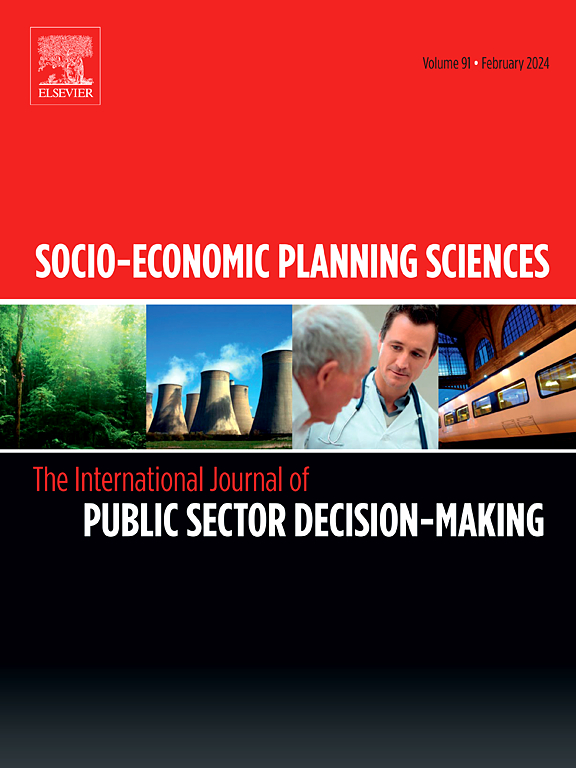Evaluating socioeconomic factors for crime against women in developing countries: A data-centric statistical learning approach
IF 5.4
2区 经济学
Q1 ECONOMICS
引用次数: 0
Abstract
Women are often targeted in crimes of sexual violence, trafficking, and domestic abuse, especially in developing countries. There are two types of risk factors for women being victims of such violence. Personal risk factors include attributes or features of the woman’s self or identity, such as how old she is, how educated she is, and whether she is married. There is a second set of factors that we call “regional” risk factors, which include the attributes or characteristics of a region (defined as a state or union territory) such as how electrified it is, how many colleges it has, or how many roads it has. We offer insights on regional risk factors and how they influence rates of crime against women in that region. We also address the challenge of under-reporting and present insights into factors that could reduce under-reporting. We use a suite of advanced machine learning techniques to identify and evaluate the socio-economic and political risk factors for high rates of both reported and adjusted crime against women in a region. We establish our research framework with a case study conducted in India, using data from different states and union territories from 2004–2020. We consider 23 factors, including the financial condition of the state, the ruling political party, access to electricity, access to education, employment rate, and birth rate. Our results show that high access to education, low gender disparity in education, low poverty, and increased household access to electricity are positively correlated with reduced crime against women. We also observe that under-reporting is more often a problem in poorer regions, regions where higher percentages of women are illiterate than men, and regions where household access to electricity is low. While policymakers cannot easily change personal risk factors, these regional risk factors can be addressed explicitly by government agencies, institutions, or leaders.
评估发展中国家针对妇女犯罪的社会经济因素:以数据为中心的统计学习方法
特别是在发展中国家,妇女经常成为性暴力、贩运和家庭暴力犯罪的目标。妇女成为这种暴力的受害者有两种危险因素。个人风险因素包括妇女自我或身份的属性或特征,例如她的年龄、受教育程度以及是否结婚。还有第二组因素,我们称之为“区域”风险因素,包括一个地区的属性或特征(定义为一个州或联邦领土),比如它的电气化程度,它有多少所大学,或者它有多少条道路。我们提供关于区域风险因素及其如何影响该区域针对妇女的犯罪率的见解。我们还解决了低报的挑战,并提出了可以减少低报的因素的见解。我们使用一套先进的机器学习技术来识别和评估一个地区报告和调整的针对妇女的高犯罪率的社会经济和政治风险因素。我们通过在印度进行的案例研究建立了我们的研究框架,使用了2004-2020年来自不同邦和联邦领土的数据。我们考虑了23个因素,包括国家的财政状况、执政党、电力供应、受教育机会、就业率和出生率。我们的研究结果表明,高受教育机会、低受教育性别差异、低贫困率和家庭用电增加与减少针对妇女的犯罪呈正相关。我们还观察到,在较贫穷的地区、女性文盲比例高于男性的地区以及家庭电力供应较低的地区,漏报往往是一个问题。虽然决策者不能轻易改变个人风险因素,但这些区域风险因素可以由政府机构、机构或领导人明确解决。
本文章由计算机程序翻译,如有差异,请以英文原文为准。
求助全文
约1分钟内获得全文
求助全文
来源期刊

Socio-economic Planning Sciences
OPERATIONS RESEARCH & MANAGEMENT SCIENCE-
CiteScore
9.40
自引率
13.10%
发文量
294
审稿时长
58 days
期刊介绍:
Studies directed toward the more effective utilization of existing resources, e.g. mathematical programming models of health care delivery systems with relevance to more effective program design; systems analysis of fire outbreaks and its relevance to the location of fire stations; statistical analysis of the efficiency of a developing country economy or industry.
Studies relating to the interaction of various segments of society and technology, e.g. the effects of government health policies on the utilization and design of hospital facilities; the relationship between housing density and the demands on public transportation or other service facilities: patterns and implications of urban development and air or water pollution.
Studies devoted to the anticipations of and response to future needs for social, health and other human services, e.g. the relationship between industrial growth and the development of educational resources in affected areas; investigation of future demands for material and child health resources in a developing country; design of effective recycling in an urban setting.
 求助内容:
求助内容: 应助结果提醒方式:
应助结果提醒方式:


